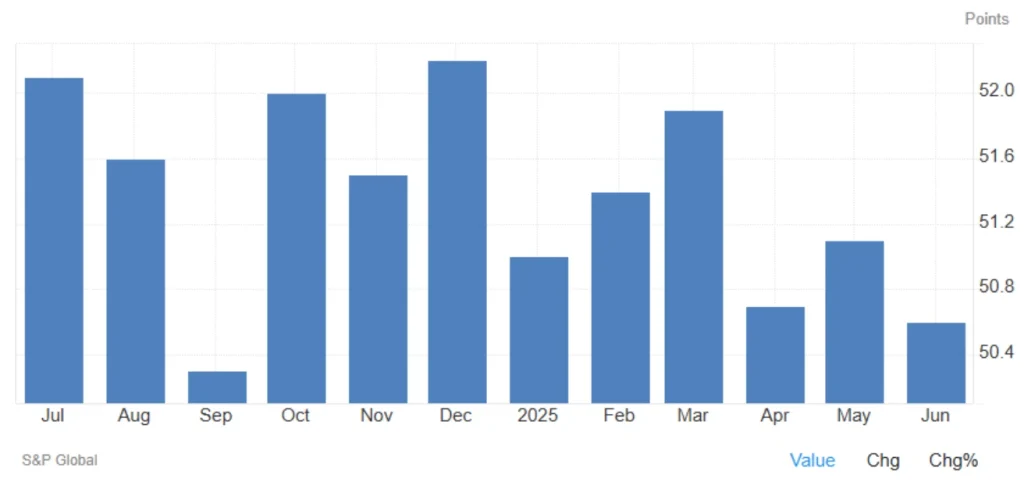
China’s Services PMI Falls to 9-Month Low – What It Means for the Global Economy
In June 2025, China’s services sector delivered one of its weakest performances in the past nine months. The Caixin China General Services PMI fell to 50.6, below market expectations of 51.0 and May’s reading of 51.1.
This soft reading signals broader challenges for the world’s second-largest economy — from slumping new orders to falling prices and softening employment.
Key Data Highlights – Caixin Services PMI (June 2025)
| Indicator | June 2025 | May 2025 | Market Forecast |
|---|---|---|---|
| 📈 Caixin Services PMI | 50.6 | 51.1 | 51.0 |
| 📉 Foreign Orders | Sharpest drop since Dec 2022 | – | – |
| 💸 Selling Prices | Fell for 5th consecutive month | – | – |
| 👥 Employment | Slight decline | – | – |
| 🧾 Input Costs | Mild increase | – | – |
| 📊 Business Confidence | Slight improvement but still below long-term average | – | – |
What Is the Caixin Services PMI?
The Caixin China General Services Purchasing Managers’ Index (PMI) is a monthly economic indicator that surveys private and mid-sized service companies in China.
- A PMI above 50 indicates expansion, while below 50 signals contraction.
- Unlike the official PMI, which focuses on state-owned giants, Caixin focuses on the private sector, offering sharper insights for global investors.
Read More: China’s Industrial Growth Slows in May 2025
What This Means: Demand Pressures & Cooling Service Inflation
The decline in the Services PMI to 50.6 — the lowest since September 2024 — reflects a slowdown in service-sector growth.
Key Trends:
- 📉 Foreign demand plunged, marking the sharpest drop since December 2022.
- 📉 Selling prices fell for the fifth straight month, highlighting intense price competition.
- 👥 Employment slipped slightly, hinting at corporate caution regarding future sales.
- 🛢 Input cost inflation remained low despite slight increases in energy and material costs.
🌤 One Positive Note:
- 📊 Business confidence ticked up for the second month, driven by hopes of domestic recovery in H2 2025, although it remains below average.
Market Outlook & Investment Implications

With weaker demand both domestically and globally, Beijing may feel growing pressure to stimulate the economy further in the months ahead.
🧠 What to Watch:
- 🇨🇳 Monetary policy signals from the People’s Bank of China (PBoC)
- 🌐 Global trade and demand shifts
- 💼 Targeted stimulus packages for services and consumption
Strategic Takeaways for Investors:
Short-Term:
- The services sector may remain under pressure.
- Currencies tied to China’s growth (like AUD, KRW) may face volatility.
- Commodity markets could see softened demand from China in Q3.
Mid-Term:
- If domestic spending rebounds and global demand recovers, China’s services may bounce back.
- Investors could look to:
- 🛢 Commodity producers
- 🏭 Industrial exporters to China
- 🧳 Consumer-facing companies in Asia
Final Word
China’s latest services data is a wake-up call for global investors. It’s not just about economic data points, it’s about understanding shifts in global demand and preparing for policy responses.
Stay ahead by tracking:
✅ PMI trends
✅ Beijing’s stimulus actions
✅ Global trade movements
Share
Hot topics

Will 2026 Be a Turning Point for Crypto Regulation in the U.S.?
The cryptocurrency world is gearing up for a transformative year as a pro-crypto administration, led by Donald Trump, prepares to take charge in the United States. With a Congress expected...
Read more




Submit comment
Your email address will not be published. Required fields are marked *